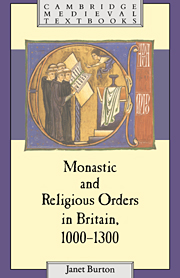Book contents
- Frontmatter
- Contents
- List of illustrations
- Preface
- 1 Before the Normans
- 2 The coming of the Normans
- 3 The regular canons
- 4 The new monastic orders of the twelfth century
- 5 Women and the religious life
- 6 The mendicant orders
- 7 The physical setting: monastic buildings and the monastic plan
- 8 Inside a religious house: daily life and the chain of command
- 9 Learning and literary activities
- 10 Religious houses and the wider community: founders, patrons and benefactors
- 11 The monastic economy
- 12 On the brink of change
- Glossary
- Notes
- Select bibliography
- Index
- Cambridge Medieval Textbooks
9 - Learning and literary activities
Published online by Cambridge University Press: 05 June 2012
- Frontmatter
- Contents
- List of illustrations
- Preface
- 1 Before the Normans
- 2 The coming of the Normans
- 3 The regular canons
- 4 The new monastic orders of the twelfth century
- 5 Women and the religious life
- 6 The mendicant orders
- 7 The physical setting: monastic buildings and the monastic plan
- 8 Inside a religious house: daily life and the chain of command
- 9 Learning and literary activities
- 10 Religious houses and the wider community: founders, patrons and benefactors
- 11 The monastic economy
- 12 On the brink of change
- Glossary
- Notes
- Select bibliography
- Index
- Cambridge Medieval Textbooks
Summary
ATTITUDES TO LEARNING
The Rule of St Benedict envisaged that a certain amount of each day not spent in the performance of the divine office or in manual labour would be devoted to reading and meditation, lectio divina; and at the beginning of Lent monks were to be given a book from the library for their personal study. Scholars have long debated what Benedict meant by lectio divina, and how far his monks were meant to engage in intellectual and literary activities beyond the contemplation of monastic and Christian classics such as those named at the conclusion of the Rule. Whatever his intention, by the beginning of our period the monasteries of western Europe were the channels through which both classical and Christian learning were diffused. Reading was important, therefore, because it was prescribed by the Rule; but it had an added significance in that it was a part of the transmission of eternal values in a society which felt a constant longing for and need to preserve the past. As well as reading, it was understood that those with talent would be allowed to engage in writing, and this had become an accepted and acceptable form of manual labour. Learning was not, however, encouraged for its own sake, but as a means to an end: to aid understanding of the Scriptures and pursuit of knowledge of God.
- Type
- Chapter
- Information
- Monastic and Religious Orders in Britain, 1000–1300 , pp. 187 - 209Publisher: Cambridge University PressPrint publication year: 1994
- 1
- Cited by

